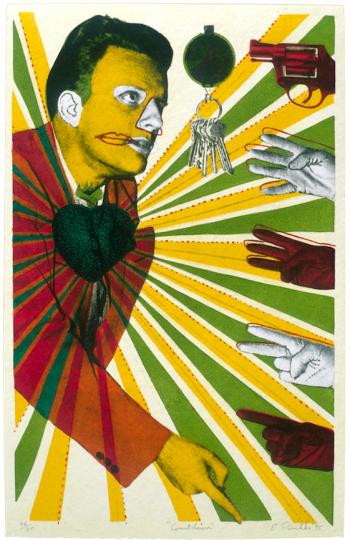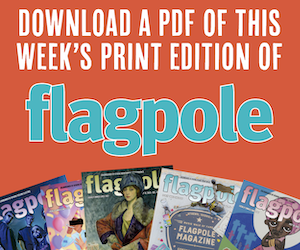Expanding the realm of possibilities with paper as a medium, the experimental printmaking workshop Mixografia excels at producing three-dimensional images that are often as deep as three inches, allowing for incredible detail. “Paper in Profile: Mixografia and Taller de Gráfica Mexicana,” currently on view at the Georgia Museum of Art through Sunday, Aug. 21, offers a survey of contemporary art created by 60 different collaborators from across the globe. While Mimmo Paladino, Ed Paschke—whose work appears on Flagpole’s cover this week—Ed Ruscha, George Segal, Donald Sultan, Rufino Tamayo and other participating artists create artwork with vastly different styles, their contributions to the exhibition are visually unified through the workshop’s unique printing process.
Established by artist Luis Remba, the Mixografia workshop originated as Taller de Gráfica Mexicana in 1968, later relocating from Mexico City to Los Angeles in the mid ’80s. Mixografia has produced handmade paper prints, multiples and sculptures for over 30 years, and the Remba family has been in the business even longer; Luis’ father owned a commercial printmaking service, and his son, Shaye, currently oversees the workshop’s production.

“Countdown” by Ed Paschke
In an effort to accommodate painter Tamayo’s desire to add more volume and fine surface detail into his work, Remba was inspired to develop a new fine-art printing process that ultimately evolved into the workshop’s signature technique. In order to create three-dimensional prints, the artist creates a maquette, or model, using any combination of solid materials that can be carved, impressed or built upon for the image. A printing plate is then cast from the maquette, and inks are applied to the plate. Wet paper is then laid on top of the inked plate and run through the press, forcing the paper pulp into the image’s depressions while simultaneously absorbing the pigments.
Given the subtle yet undeniably three-dimensional nature of the works, “Mixografia” is best experienced in person. Not until you’re able to view an artwork from multiple angles and watch as shadows gently shift can you truly appreciate its physical depth. The canvases by Larry Rivers, for example, nearly take the form of giant shadowboxes as characters pop from their backgrounds. His artwork straddles the line between printmaking and sculpture through a combination of acrylics, photo litho on paper, cast resin fiber and wood. “Mixografia” also features several sculptural works, such as Frank Stella’s rollercoaster-esque creations assembled from bamboo, carbon fiber and resin, and Jorge Pardo’s wall-bound diptych print that allows windows of light to shine through its golden surface.
Californian conceptual artist John Baldessari is a major focal point of the exhibition, with a handful of fun pieces on view. “Stonehenge (With Two Persons),” a collection of six prints in various color combinations, is representative of an odd practice the artist is often recognized for: obscuring faces in black-and-white photographs with colored dots. Often incorporating found photography and appropriated imagery into his work, Baldessari began placing price stickers over faces more or less on a whim. He found, however, that depersonalizing the human subjects could channel viewers’ interest towards subtle details and larger, more universal ideas. Instead of focusing on two vacationing men, Baldessari encourages viewers to contemplate the origins of the mysterious megaliths.
Louise Bourgeois, the French-American installation artist best remembered for her terrifyingly large yet benevolent spider sculptures, agreed to create an edition of prints for Mixografia after seeing the sculptural possibilities offered through the workshop’s unique process. Bourgeois used string as the drawing tool to make maquettes for “Crochet I–V, ” a series that weaves and knots red string into forms that realistically float on the surface of their white backgrounds. An extension of domesticity, a theme often explored throughout her career, the images vary from a densely woven net or irregularly looping patterns, to a pair of symmetrical compositions to a representation of a woman’s braided hair.

“Red Flowers” by Donald Sultan
The museum’s thrice-annual art party Museum Mix will be held on Thursday, June 16 from 8–11 p.m., right after a Thursday Twilight Tour focusing on highlights from the permanent collection at 7 p.m. In addition to music by DJ Mahogany and snacks from Big City Bread, Museum Mix offers late-night access to all galleries. Current temporary exhibitions include “VVOX: Refining Realities” and “Frank Hartley Anderson: Forging the Southern Printmakers Society”—both of which close this weekend—as well as “George Segal: Everyday Apparitions,” “Turned and Sculpted: Wood Art from the Collection of Arthur and Jane Mason” and “Twists and Turns: Sculptures by Alice Aycock.”
A three-week film series will delve into the illustrious careers and personal lives of several Mixografia artists. Louise Bourgeois: The Spider, the Mistress and the Tangerine, screening on Thursday, July 7, connects several major installations to the life events that inspired them. The following Thursday is a double feature screening Kiki Smith: Squatting the Palace, a documentary that follows the artist as she prepares for an eight-room installation in Venice, Italy, and A Brief History of John Baldessari, a humorous six-minute short narrated by Tom Waits. The series closes out on Thursday, July 21 with Miracle and Premium, two oddly plotted films by artist Ed Ruscha. All films begin at 7 p.m.
Other correlated events include an Artful Conversation on Wednesday, June 29 at 2 p.m.; a Sunday Spotlight Tour on Sunday, July 10 at 3 p.m.; a Tour at Two led by docents on Wednesday, July 27 at 2 p.m.; and an additional Tour at Two with exhibition curator Lynn Boland on Wednesday, Aug. 17 at 2 p.m. The Friends of the Georgia Museum of Art will host its quarterly reception, 90 Carlton: Summer, on Friday, July 22 from 6–9 p.m. Earlier that day at 2 p.m., Shaye Remba will visit the museum for a Q&A moderated by Boland.
Like what you just read? Support Flagpole by making a donation today. Every dollar you give helps fund our ongoing mission to provide Athens with quality, independent journalism.










